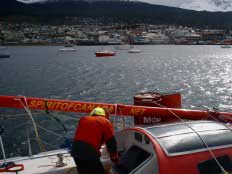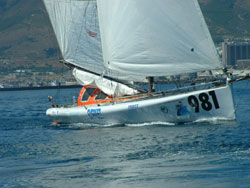Everest Horizontal Finishes Second
In Cape Town To Salvador, Brazil Leg
Milwaukee Native Tim Kent Almost Around,
Brad Van Liew, Freedom America, Solidly In First
Derek Hatfield, Spirit of Canada, Dismasted In Third
By Captain Thom Burns
Depending on the time zone, mine and his, I’ve been Tim Kent’s silent
companion and cheerleader around most of the globe. How anyone can write
like he does on very limited sleep, with a tremendous workload while sailing
a fifty footer by himself never ceases to amaze me.
Reading his Everest Horizontal updates will raise your spirits as he reveals
his. This is a very fine sailor and person.
The drama of the daily struggles with weather, seas and particularly
equipment when he is trying to manage the boat by himself keeps my interest.
Many of the little daily successes such as catching a part before it fails
is due to the routines these solo sailors establish for themselves. The
ability to carry out the inspections in all types of weather and sea
conditions is often the difference between a breakdown and happy sailing.
These sailors are actually conservative racers in many ways. “Broken boats,
do not finish” seems to be a cardinal rule amongst all the competitors.
It is gratifying even from long distance to see these competitors grow deep
friendships. They are tremendous supporters of one another. Brad Van Liew
gave his used halyards to Tim. Shore support folks from one team help
another. The camaraderie is heartfelt and deep.
Here is Tim reflecting on his friend Derek Hatfield’s problems. “Yesterday,
more disaster befell one of the best people in this race. Derek Hatfield on
Spirit Of Canada was dismasted off Cape Horn.”
Here is an account of the dramatic pitchpole of Spirit of Canada. Spirit of
Canada was the last boat in the Southern Ocean. Hatfield and fellow
competitor Alan Paris had been watching an intense low pressure system
approaching and they knew that they were in for some rough conditions, but
they did not know that the actual wind strengths would be way in excess of
the forecasted ones. About a day and a half before getting to Cape Horn the
wind started to blow. Once it got above 40 knots Derek had to hand steer the
boat because that amount of wind, and the size of the waves, was too much
for the autopilots. So began a long, long stint at the helm. "The waves were
really starting to get huge as I approached Cape Horn," Derek said in a
phone interview. "They were at least 40 to 50 feet with breaking crests. I
knew that if one of them got the boat we would be in trouble, but because I
was on deck at the helm I could see them coming and steer away from them."
As Derek and Spirit of Canada got closer to Cape Horn the waves began to
increase in size as the continental shelf caused the water to shallow. They
were also getting dangerously steep.
Hatfield had stood way off land and figured he was about 10 miles south of
Cape Horn when he passed it’s longitude. "I never saw the land," he said.
"And I was glad of it, I wanted to be far away because the visibility was
very bad. We were getting slammed by a hail storm and the wind was picking
up the waves making a real mess of things." It was sometime mid-afternoon
when the wave that had his name on it came up from behind. "I have lost the
timeline a bit," Derek said. "I was so exhausted that I could hardly think,
but when I heard the wave I knew that I was in trouble. It was not as big as
some of the others, but it was breaking and it made a huge roar as it
approached the boat. In seconds we were falling down the face of it until
the bow dug in and then we pitchpoled. The boat went straight up and then
fell over sideways. I was at the back of the boat and got flung forward, and
the next thing I knew I was in the water under the boat." Spirit of Canada
had just undergone the worst possible scenario; an end-over-end capsize. The
boat slammed down trapping the skipper underneath it. Derek continued his
story. "I heard the water gurgling and knew that I was under the boat, then
all of a sudden I heard explosions. Loud explosions that reverberated
through the water and I knew in that instant that the mast was breaking. It
was unreal. Gurgling water and huge bangs. Suddenly without the mast the
boat came back upright and I was dragged back on deck." Hatfield estimated
that he was under the boat for about 15 seconds. Had the mast not broken who
knows if it would have ever come back up again and how Derek would have got
out from underneath the boat. It boggles the mind to think about it.

Derek Hatfield aboard dismasted Spirit of Canada in
Ushaisa, Argentina.

Tim Kent aboard Everest Horizontal starting a warmer leg.
During the pitchpole the keel had come loose. It had already been a problem, but now the whole thing was loose and banging around. Once he had cut the mast away (salvaging the boom in the process) Derek began to motor slowly towards land. "The crazy thing was that my engine was running before we capsized," he said. "When we came back up again it was still running and continued to run until we made landfall in the Beagle passage."
This morning when the sun came out and Spirit of Canada was alongside the dock in Ushuaia the problems that lay ahead looked insurmountable. There was no mast, no sails or rigging. The keel problem needed to be resolved. The electronics were ruined. "I could not think how we could get back in the race given where things stood," Derek said. "But then I opened my email and started to talk to people and I am amazed and gratified by the outpouring of support we have been getting. It’s overwhelming. There is still a lot to do, but I am starting to feel the littlest bit confident that we might just be able to get back into the race. My goal is to get a new mast, get this boat sorted and return to the spot where I capsized. If I do that and then sail to Salvador in time for the last leg, and do well in that leg, I believe that I can maintain my podium place. That’s my goal. To finish in the top three for the Around Alone." Those are fighting words spoken by a man who is amply capable of making things happen. The obstacles are enormous, but so is the will. None of us here in Salvador are surprised by the outpouring of support. Derek Hatfield is an easy man to support. You know that he will give it a 100 percent effort and don’t be surprised if you see this great sailor on the start line for Leg 5.
Brad Van Liew aboard Freedom America has won the first four legs and only needs to finish Leg 5 from Salvador, Brazil to Newport, Rhode Island to win Division II. Tim Kent aboard Everest Horizontal is pretty much in the same boat for second with three seconds and a third. If Derek Hatfield can get back in the race, he should nudge out Kojiro Shiraishi aboard Spirit of yukoh third.
Visit the web sites listed below for a great number of inspirational sailing stories.
www.everesthorizontal.com
www.aroundalone.com
Thanks to both organizations for providing invaluable material for this article.
Captain Thom Burns publishes Northern Breezes.